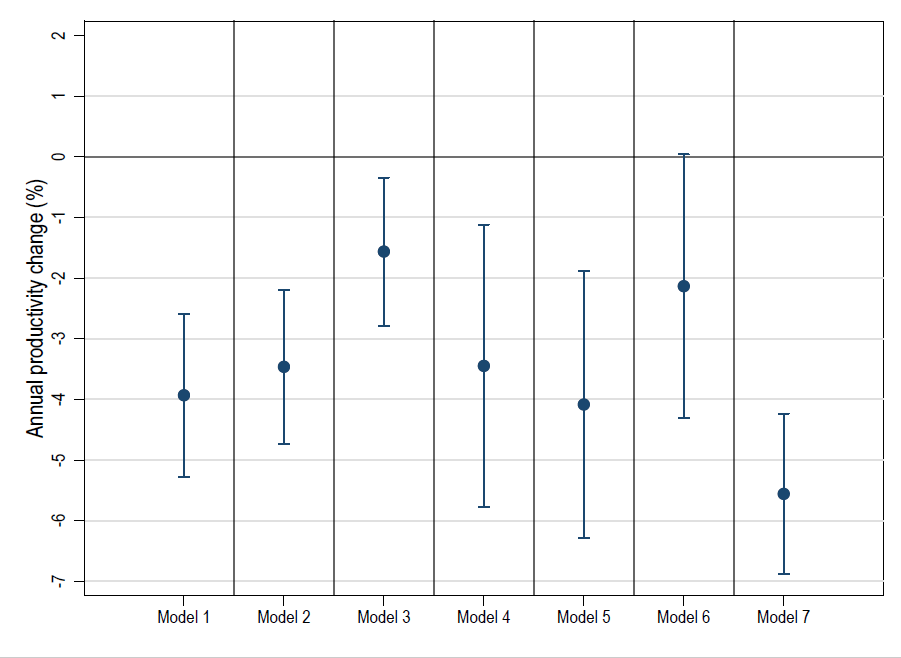
What has new evidence taught us about the evolution of smallholder agricultural productivity in sub-Saharan Africa over recent decades?
The importance of smallholder agriculture for the Sustainable Development Goals in Africa
Close to 80% of Africa’s extreme poor reside in rural areas, where much of their income is derived from smallholder farming (World Bank 2022a). Productivity in smallholder agriculture thus matters for poverty alleviation, food security, and global development more broadly, as embodied in the Sustainable Development Goals (SDGs). SDG target 2.3 establishes as an explicit goal “by 2030 [to] double the agricultural productivity and the incomes of small-scale food producers… “ (UN General Assembly 2015). This target is seen as instrumental to progress towards achieving SDG1 (End Poverty) and SDG2 (Zero Hunger).
With just over five years remaining for the delivery of the SDGs, what do we know about the evolution of smallholder agricultural productivity in Sub-Saharan Africa over recent decades?
The evolution of smallholder agricultural productivity in sub-Saharan Africa
Much of the existing evidence comes from research that uses annual time series data, aggregated at the country level. Most of this data is reported by national agricultural ministries and then compiled by the United Nations Food and Agriculture Organization (FAO) and other entities. These sources have generally suggested modest improvements in agricultural productivity in Africa. For instance, the USDA’s Economic Research Service (ERS) has reported gradual increases in Total Factor Productivity (TFP) for several African countries (USDA 2021). However, these aggregate statistics can mask significant variations within countries and often fail to capture the realities faced by smallholder farmers. Moreover, research has suggested potential shortcomings in aggregate statistics (Devarajan 2013, Jerven and Johnston 2015).
In a recent study, we instead draw on micro-data from 55,000 smallholder farms with 180,000 distinct plots to answer this question (Wollburg et al. 2024). We compiled data from the Living Standards Measurement Study – Integrated Surveys on Agriculture (LSMS-ISA) from six sub-Saharan African countries - Ethiopia, Malawi, Mali, Niger, Nigeria and Tanzania – spanning the period from 2008 to 2019. These countries have a combined population of about 480 million individuals, including nearly 1 in 5 of the world’s extreme poor (World Bank 2022b). The data is nationally representative of their populations, allowing us to infer national trends in smallholder yields and productivity in these six countries.
Smallholder crop yields in Sub-Saharan Africa are falling
Our findings suggest that smallholder yields and productivity are falling, or at the very least, not rising. The raw time trend in yields is -3.9% per year, while our preferred model for total factor productivity suggests a decline of 3.5% annually. We also find an overall productivity decrease in several other statistical specifications. However, there is significant cross-country heterogeneity. Nigeria plays a key role in the negative overall trend, while we find that agricultural productivity has increased in Niger between 2011 and 2014.
Figure 1: Productivity trend in different statistical models.

Source: Wollburg et al. (2024), PNAS
The analysis also suggests that the yield declines cannot be readily attributed to changes in weather or environmental conditions, nor are they explained by changes in the composition of crops, entry and exit of more or less productive farms into the sample, outliers or extreme values, or by different productivity measures.
One of the limitations of our data is that we do not capture (large) commercial farms, which may have experienced differing agricultural productivity trends in the same period. Recent research suggests the emergence of commercialised medium-and large-scale farms in Sub-Saharan Africa which our data may not adequately reflect (Jayne et al. 2019). In addition, our focus on crop farming means we do not capture productivity trends among animal agriculture or some other types of agricultural activities (e.g. tree crop farming).
Implications for agricultural development in Sub-Saharan Africa
Our findings raise concerns about the likelihood of achieving the SDG targets. The issue of smallholder food production and productivity will continue to matter, particularly given the effects of climate change, that may lead to more frequent crop failure.
Further research should focus on understanding the dynamics underlying these disturbing trends in the smallholder sector. In ongoing work, we are exploring the hypothesis that urbanisation and the growing importance of non-farm sector activities may be causing labour to shift away from agriculture.
Editor’s Note: Read our VoxDevLit on Agricultural Technology in Africa.
References
Devarajan, S (2013), “Africa’s statistical tragedy,” Review of Income and Wealth, 59(S1): S9–S15. https://doi.org/10.1111/roiw.12013.
Jayne, T S, M Muyanga, A Wineman, H Ghebru, C Stevens, M Stickler, A Chapoto, W Anseeuw, D Westhuizen, and D Nyange (2019), “Are medium-scale farms driving agricultural transformation in Sub-Saharan Africa?” Agricultural Economics, 50(S1): 75–95. https://doi.org/10.1111/agec.12535.
Jerven, M, and D Johnston (2015), “Statistical tragedy in Africa? Evaluating the data base for African economic development,” The Journal of Development Studies, 51(2): 111–115. https://doi.org/10.1080/00220388.2014.968141.
UN General Assembly (2015), Transforming Our World: The 2030 Agenda for Sustainable Development. (General Assembly Resolution A/RES/70/1, UN General Assembly).
USDA (2021), “International agricultural productivity (database),” Available at: https://www.ers.usda.gov/data-products/international-agricultural-productivity/.
Wollburg, P, T Bentze, Y Lu, C Udry, and D Gollin (2024), “Crop yields fail to rise in smallholder farming systems in Sub-Saharan Africa,” Proceedings of the National Academy of Sciences, 121(21): e2312519121. https://doi.org/10.1073/pnas.2312519121.
World Bank (2022a), Poverty and Shared Prosperity 2022: Correcting Course.
World Bank (2022b), World Development Indicators (Database), Available at: http://data.worldbank.org/data-catalog/world-development-indicators.





